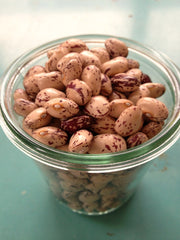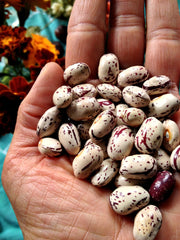Bean, Pole Dry, 'Borlotto Gaston'
(P. vulgaris) Borlotto, or cranberry beans (as they are known in the US) are a staple of northern Italian cuisine, and none is prized more than the famed Borlotto Lamon of the Veneto. For years Anthony and Carol Boutard maintained the variety at Ayers Creek Farm in Gaston, Oregon from its original Italian stock with the goal of slowly adapting a Pacific Northwest strain. They renamed it to both reflect its new home and give a nod to its roots. In his book, Beautiful Corn, Anthony describes the Gaston (Lamon): "There are several reasons why this variety is not more available commercially. Pole beans cost more to grow, and the Lamon must be handpicked and has just three or four (HUGE!) beans per pod compared to the usual five to seven. It also ripens late, and splits in the rain,.. Mere details, considering that it is perfect, the most glorious of the cranberry beans. We cannot imagine winter without it".
If you are like me, that is a perfect invitation for the stubbornly defiant grower! These are also a delicious shelly bean that we've managed to grow with absolute success (through the dry stage) up north, so if your season starts looking like it might be shorter than you thought, simply pick, freeze, and dream of delightful winter meals.
100-105 days. UO
Packet: 40 seeds
Availability: In stock
Growing Info
SOWING:
Direct seed after the last frost date when the soil has warmed.
Note: Beans prefer well-drained, warm soil.
PLANTING DEPTH:
1"
SPACING:
3-5" between plants with 12-24" between rows*
*Pole beans require 5+' between rows.
EMERGENCE:
5-10 days @ soil temp 65-90F
LIGHT:
Full sun to part shade
FERTILITY:
Light to Moderate. Beans can produce their own usable nitrogen from atmospheric nitrogen through a symbiotic relationship with bacteria that colonize specialized nodules in their roots. Too much soil fertility can cause excessive vegetative growth at the expense of pod set and maturity.
Beans prefer well-drained, warm soil with a pH between 6.0-7.0.
ADDITIONAL NOTES:
Beans prefer warm soils and may rot at lower temperatures. This is particularly true for white-seeded varieties. You love beans. Patience.
It can be quite beneficial to mix bean seeds with commercially available bacterial "inoculants" to encourage the beneficial symbiotic relationship in the growing plant's root nodules, especially if growing on ground that hasn't been planted with beans before. This can increase yields and improve plant health.
Avoid picking/weeding beans when the plants are wet. This will help prevent the spread of disease.
Provide a trellis for pole beans.
White-seeded varieties are more susceptible to rot when seeded in cool, wet, early-season conditions.
Sow Snap Beans every few weeks for continued harvests.
Harvest dry beans when the pods are brown and dry.




